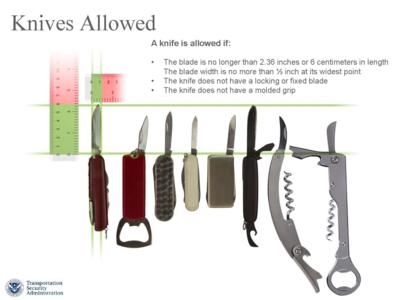Thu, Mar 07, 2013
Flight Attendants' Unions Strongly Oppose The Change
Beginning April 25th, if you have your grandfather's favorite pocket knife in your pocket when you go through airport security, it just might not be confiscated and tossed in a bin at the checkpoint. But that decision is being blasted by flight attendants unions.

TSA reports on their official blog that beginning next month, some small pocket knives and sporting goods items like hockey sticks and golf clubs will allowed in the passenger cabin of an airplane. TSA established a committee to review the prohibited items list based on an overall risk-based security approach. After the review, TSA Administrator John S. Pistole made the decision to start allowing the following items in carry-on bags beginning April 25th:
- Small Pocket Knives – Small knives with non-locking blades smaller than 2.36 inches and less than 1/2 inch in width will be permitted
- Small Novelty Bats and Toy Bats
- Ski Poles
- Hockey Sticks
- Lacrosse Sticks
- Billiard Cues
- Golf Clubs (Limit Two)
TSA said on the blog that this is part of an overall Risk-Based Security approach, which allows Transportation Security Officers to better focus their efforts on finding higher threat items such as explosives. This decision aligns TSA more closely with International Civil Aviation Organization (ICAO) standards.
These similar items will still remain on the prohibited items list:
- Razor blades and box cutters will remain prohibited in carry-on luggage.
- Full-size baseball, softball and cricket bats are prohibited items in carry-on luggage.

The announcement was met with strong opposition by a coalition of flight attendants' unions, which said in a news release that the policy shift is a "poor and shortsighted decision by the TSA. Continued prohibition of these items is an integral layer in making our aviation system secure and must remain in place.
"As the last line of defense in the cabin and key aviation partners, we believe that these proposed changes will further endanger the lives of all flight attendants and the passengers we work so hard to keep safe and secure.
"Flight attendants are the front line safety and security professionals onboard every commercial passenger aircraft in this country and must be given the tools and training to protect ourselves, our passengers and the aircraft. Despite repeated requests for updated training to include basic self-defense maneuvers to allow us to defend ourselves, Flight attendants still do not receive mandatory training about how to effectively recognize and defend others against attacks aboard the aircraft."
(Image provided by TSA)
More News
Witness Reported The Airplane Was Flying Low And Was In A Left Bank When It Struck The Power Line Analysis: The pilot was on final approach to land when the airplane collided with >[...]
How To Get A Story On Aero-TV News/Feature Programming How do I submit a story idea or lead to Aero-TV? If you would like to submit a story idea or lead, please contact Jim Campbel>[...]
From 2012 (YouTube Edition): A Segment Of The Sport Aviation World That Truly Lives "Low And Slow" Pity the life of ANN's Chief videographer, Nathan Cremisino... shoot the most exc>[...]
Aero Linx: International Business Aviation Council (IBAC) IBAC promotes the growth of business aviation, benefiting all sectors of its industry and in all regions of the world. As >[...]
Execute Missed Approach Instructions issued to a pilot making an instrument approach which means continue inbound to the missed approach point and execute the missed approach proce>[...]
 NTSB Final Report: Cozy Cub
NTSB Final Report: Cozy Cub ANN FAQ: Contributing To Aero-TV
ANN FAQ: Contributing To Aero-TV Classic Aero-TV: Seated On The Edge Of Forever -- A PPC's Bird's Eye View
Classic Aero-TV: Seated On The Edge Of Forever -- A PPC's Bird's Eye View ANN's Daily Aero-Linx (04.29.25)
ANN's Daily Aero-Linx (04.29.25) ANN's Daily Aero-Term (04.29.25): Execute Missed Approach
ANN's Daily Aero-Term (04.29.25): Execute Missed Approach




